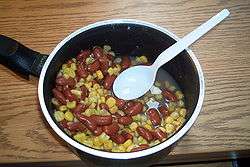Succotash
.jpg)

Succotash (from Narragansett sohquttahhash, "broken corn kernels"[1]) is a food dish consisting primarily of sweet corn with lima beans or other shell beans. Other ingredients may be added including tomatoes, green or sweet red peppers,[2] and okra. Combining a grain with a legume provides a dish that is high in all essential amino acids.[3][4] Because of the relatively inexpensive and more readily available ingredients, the dish was popular during the Great Depression in the United States. It was sometimes cooked in a casserole form, often with a light pie crust on top as in a traditional pot pie. Succotash is a traditional dish of many Thanksgiving celebrations in New England[5] as well as in Pennsylvania and other states. In some parts of the American South, any mixture of vegetables prepared with lima beans and topped with lard or butter is called succotash. Corn (maize), American beans, tomatoes, and peppers are New World foods.
Cultural references
- "Sufferin' succotash" is a catchphrase used by Looney Tunes cartoon character Sylvester the Cat.[6]
- "My supper dish, my succotash wish" is a line from the 1990 dance record "Groove Is in the Heart" recorded by Deee-Lite.
- "Make a wish, make a succotash wish" is a line from the 2001 rock album Anthology by Alien Ant Farm. This song was the band's first song ever written and performed, and it is also featured on their $100 EP.
- "Succotash" is the title of the first track from Herbie Hancock's 1963 album Inventions and Dimensions [7][8]
- In an episode of the Saturday morning cartoon show Casper and the Angels titled "The Impossible Scream", two recurring characters named Nerdley and Fungo sit down at a restaurant and attempt to order succotash with toast, a kaiser roll, and a cinnamon bun, being successively told every time by an increasingly frustrated waiter that they are out of succotash. Ultimately, they try to order succotash by itself, much to the waiter's exasperation.
See also
References
- ↑ Trumbull, James Hammond (1903). Natick Dictionary. US Gov Printing Office. Entry for sohquttahham.
- ↑ "succotash". The American Heritage Dictionary of the English Language (4 ed.). Houghton Mifflin Company. 2004. Retrieved 2009-02-21.
- ↑ Annigan, Jan. "Nutritional Sources of Essential Amino Acids". Retrieved 5 June 2017.
- ↑ "Essential Amino Acids". hyperphysics.phy-astr.gsu.edu. Retrieved 5 June 2017.
- ↑ Morgan, Diane and John Rizzo. The Thanksgiving Table: Recipes and Ideas to Create Your Own Holiday Tradition. Pg. 122.
- ↑ "Sylvester the Cat - A Favorite Cartoon Cat". Best-cat-art.com. Retrieved 5 June 2017.
- ↑ Project, Jazz Discography. "Herbie Hancock Catalog". Jazzdisco.org. Retrieved 5 June 2017.
- ↑ Roberts, John Storm (1999). Latin jazz : the first of the fusions, 1880s to today. New York: Schirmer. p. 139. ISBN 0-02-864681-9.
Further reading
- Harper Fussell, Betty (2004). The Story of Corn. UNM Press. pp. 184–185. ISBN 0-8263-3592-6.